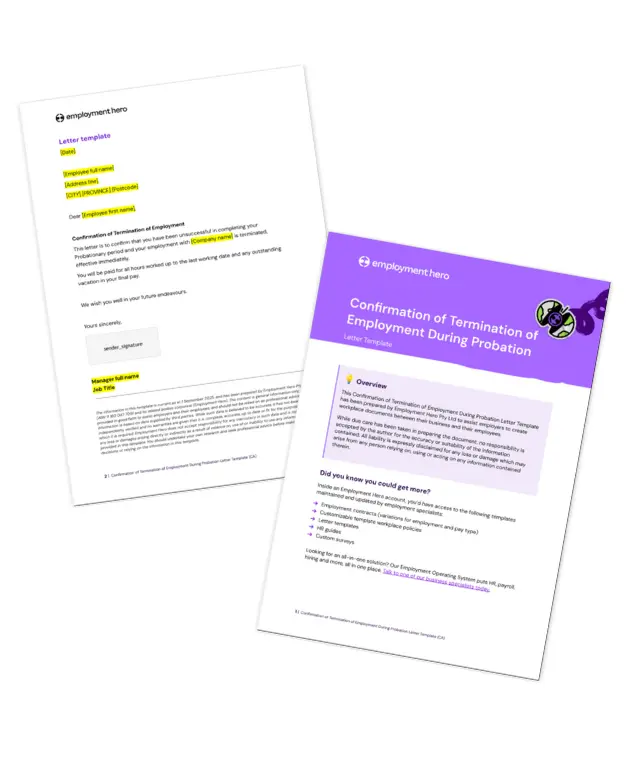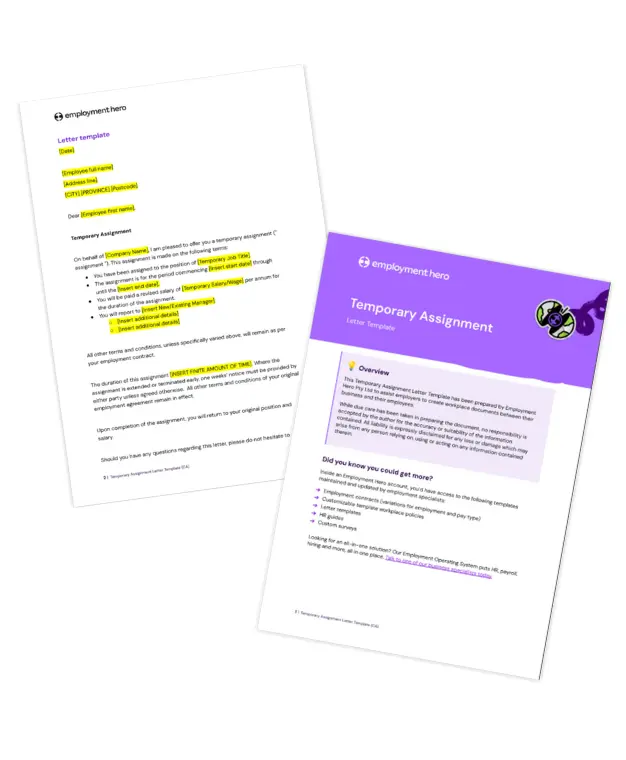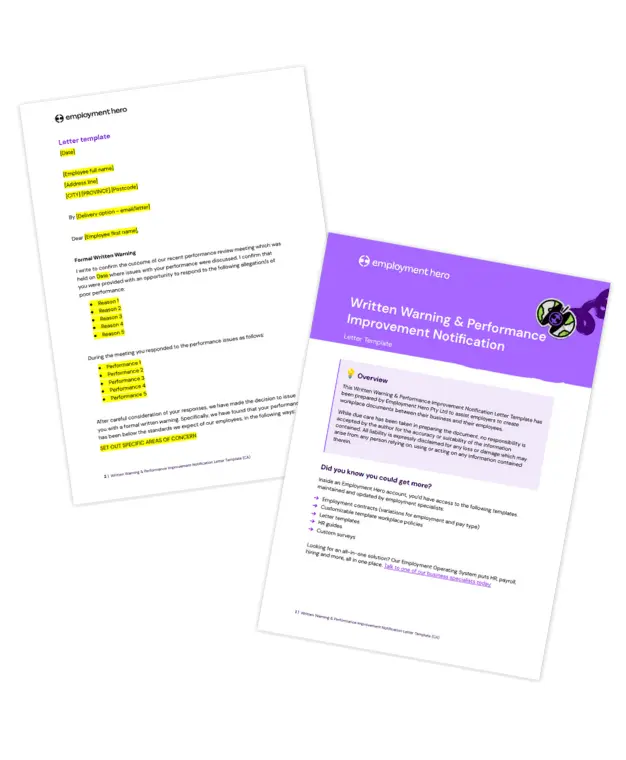Notice of termination of employment during probationary period
Published
Notice of termination of employment during probationary period
Published
The probationary period is meant to be a trial run for both the employer and the employee. It gives you the opportunity to assess whether the new hire is the right fit for the role and the organization, while giving the employee time to decide whether the position meets their expectations. Sometimes, despite best efforts, things don’t work out.
When that happens, employers need to handle termination properly. Doing so requires balancing compassion with compliance and making sure the process is documented correctly. This guide explains what termination during probation means, how the law treats it and how to draft a clear, professional notice of termination letter.

What is termination during the probationary period?
A probationary period is the introductory stage of employment that usually lasts between three and six months, depending on what is written in the employment contract.
During this time, employers are able to evaluate a new employee’s skills, conduct and overall suitability for the position. If an employee is not meeting expectations, employers may decide to terminate the relationship before the probation period ends.
Unlike the termination of a permanent employee, probationary terminations are treated differently under Canadian employment law. For many provinces, employment standards legislation does not require notice of termination if the employee has worked for less than three months. However, the presence of a probation clause in the contract does not give employers unlimited freedom.
Courts in Canada have consistently found that probationary employees must be given a fair opportunity to demonstrate their ability, and if termination occurs, it must be based on an honest and reasonable assessment. This means employers cannot dismiss someone arbitrarily or in bad faith, even during probation.
The proper process for terminating during probation
Even when termination is permitted under law and contract, there is a right way to approach it. Treating it as a step-by-step process helps you stay fair, professional and compliant. Here’s how:
Step 1: Review the employment agreement
Start with the contract. It should set out the length of the probationary period and any rules about termination during that time. If it is silent, you default to the provincial employment standards. In most provinces, those standards do not require notice if the employee has worked less than three months.
Step 2: Assess whether the employee had a fair trial period
Before moving forward, ask yourself whether the employee was truly given a chance to succeed. Have you provided feedback? Did they have access to the right training, tools and support? Canadian courts expect employers to show that probation was more than just a formality. If you end the relationship without giving the employee a proper opportunity to prove themselves, you could face a wrongful dismissal claim even if notice is not required by statute.
Step 3: Make the decision and plan the conversation
Once you are confident that termination is the right call, prepare for the meeting. Be ready to deliver the decision respectfully and clearly. Keep the conversation concise and professional, focusing on the facts rather than personal criticism.
Step 4: Deliver the decision in person
Schedule a private meeting with the employee. State the decision directly, confirm the last working day and explain what will happen next. This prevents confusion and ensures the message is communicated in a respectful way.
Step 5: Follow up with a written termination letter
After the meeting, provide a written notice of termination. This letter should confirm the effective date, outline when and how final pay will be provided and note any administrative details such as returning company property.
Step 6: Keep records
File a copy of the termination letter and meeting notes in the employee’s record. Having documentation on file shows you handled the process correctly and helps you meet provincial record-keeping obligations.
How to draft a termination notice during probation
A termination letter during probation does not need to be complicated, but it should be thoughtfully written. At a minimum, the letter should confirm that the employee’s probationary period is ending and that their employment will not continue. It should clearly identify the last day of work, explain when and how final pay will be provided, and set out any administrative requirements such as the return of equipment or access cards.
Tone matters. While probationary termination can be straightforward from a legal perspective, it can still be difficult for the employee receiving the news. A respectful, professional letter helps maintain goodwill and avoids unnecessary friction. The letter does not need to provide extensive reasons for termination, but it should be phrased in a way that acknowledges the employee’s contribution during their time with the organization.
Employers should also keep a signed copy of the letter in the employee’s file. This provides evidence that the termination was properly communicated and ensures compliance with provincial record-keeping requirements. Having the right documentation can be important if your business is audited or if questions arise in the future about how the termination was handled.
What does Canadian law say about probationary terminations?
The rules around termination during probation vary by province, but there are some general principles that apply across Canada.
Probation must be contractually agreed
A probationary period is not automatically assumed in Canadian employment law. For it to be enforceable, it must be clearly outlined in the employment contract. If an employer tries to rely on probation without having it written into the agreement, the employee may be entitled to statutory or even common law notice, regardless of how short their service was.
Statutory notice may not apply in the first three months
Most provincial employment standards acts, including those in Ontario, Alberta and British Columbia, do not require notice of termination if the employee has been employed for less than three consecutive months. This means that if an employer ends employment during this initial period, they may not owe notice or termination pay under the statute. However, if the employee has worked beyond three months, statutory notice kicks in, even if the probation period in the contract is longer. For example, in Ontario, once the three-month mark is passed, the Employment Standards Act requires a minimum of one week’s notice for employees who have worked more than three months but less than one year.
Common law protections still apply
Even when employment standards legislation does not require notice, courts may still award common law notice if the termination is found to be unreasonable or carried out in bad faith. The courts expect that employers use probation fairly, meaning they must provide feedback, evaluation and an honest assessment before deciding to terminate. If no effort was made to assess the employee’s performance, the termination may not hold up under common law.
Final pay requirements must be followed
Each province has rules around when final wages must be paid. For instance, in Ontario, employers must pay all outstanding wages, including vacation pay, by the next regular payday or within seven days of termination, whichever is later. Other provinces, like British Columbia and Alberta, have similar timelines. Failing to follow these requirements can result in penalties and compliance issues.
Employers must act in good faith
Termination during probation should never be arbitrary. Canadian courts take a strong view against employers who act in bad faith by terminating employees without fair consideration, using discriminatory reasons or failing to communicate properly. Even probationary employees have the right to be treated with honesty and fairness.
Download your termination during probation letter template
Nobody looks forward to writing a termination letter, but it is one of those tasks that needs to be done right. A well-structured letter ensures clarity, professionalism and compliance with Canadian employment standards. Instead of starting from scratch, you can download our termination during probation template.
It has the essential wording already prepared, is easy to customize and saves time when you need to act quickly. Simply add the details, print or send and move forward knowing you have the process covered.
Register for the template
Related Resources
-
 Read more: SR&ED Made Simple: A beginner’s guide on how to get up to 64% of technical salaries back as cash!
Read more: SR&ED Made Simple: A beginner’s guide on how to get up to 64% of technical salaries back as cash!SR&ED Made Simple: A beginner’s guide on how to get up to 64% of technical salaries back as cash!
Learn how to claim up to 64% of technical salaries back with SR&ED. Free webinar for Canadian startups and HR…
-
 Read more: Temporary assignment letter template for Canadian employers
Read more: Temporary assignment letter template for Canadian employersTemporary assignment letter template for Canadian employers
Need to draft a temporary assignment letter? Use our expert template to clearly outline employee roles, duration & expectations for…
-
 Read more: An employer’s guide to written warning (+Free template)
Read more: An employer’s guide to written warning (+Free template)An employer’s guide to written warning (+Free template)
Need to issue a written warning? Stay compliant and professional with our expert guide and free warning letter template.

















